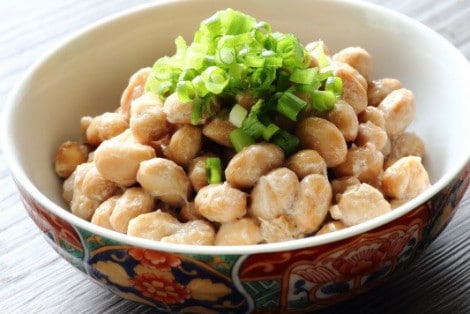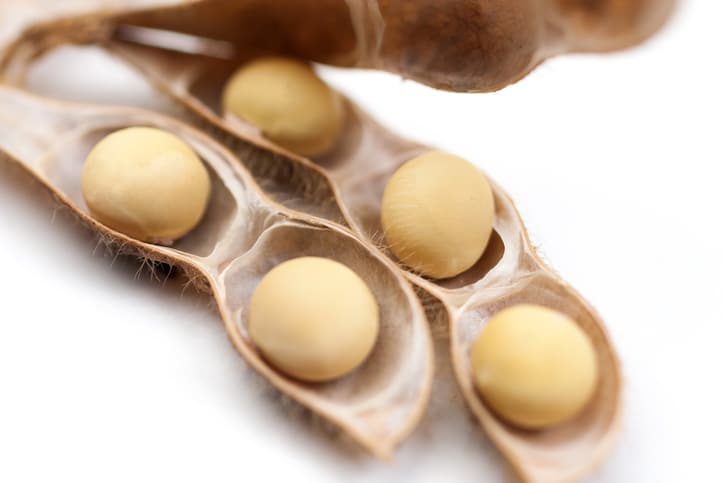Americans are discovering an ultra-potent, all-natural probiotic food that the Japanese have been using to maintain good health for over 1,000 years.1
Researchers say that it is the world’s most powerful probiotic food. One scientist noted it provides vital healthful bacteria in amounts “greater than what you would find in a typical probiotic food.”
It’s called natto. It is made from fermented soy beans. But natto is nothing like the typical soy products sold at your supermarket.
Unlike natto, over 90% of the soy grown in the U.S. is genetically modified. Mass-produced, unfermented GMO soy is linked to hormone disruption, breast cancer, thyroid problems, and digestion issues… Even Alzheimer’s.2
Natto is made by soaking non-GMO whole white soy beans, then steaming or boiling them. The beneficial bacteria Bacillus subtilis are added. Then the mixture is allowed to ferment for two days or more.
The result? The most powerful natural probiotic scientists have ever studied.
Even people with soy allergies can tolerate natto. This is because the fermentation process breaks down proteins that cause food sensitivity.3
And now natto is becoming available in the U.S.
Recommended for You: The Anti-Cancer Cocktail
Health “experts” say this drink is bad for you. But a 2011 Harvard study found that men who drink 1–3 cups daily reduce their risk of prostate cancer by 30%. And research from Boston’s Brigham and Women’s Hospital and Harvard Medical School shows this beverage lowers the risk of basal cell carcinoma by 20%.
It’s no wonder that Women’s Health magazine calls it “the drink that fights cancer.” Best of all? Guaranteed you already have some in your home. More details found HERE.
The Ancient Japanese Secret to Better Gut Health
Dr. Ann Yonetani teaches food science at the New School in New York City and is a Columbia University trained specialist in cell reproduction.
She says that each tablespoon of natto contains a billion of the healthful soil bacteria Bacillus subtilis. This microbe is linked to a stronger immune system and a wide range of other health benefits.4
Dr. Yonetani says that modern industrial food production strips away many of the beneficial bacteria that are necessary for our gut to function well.
“Food used to be fresh and dirty. We lived surrounded by nature,” she said. “Nowadays, we are exposed to too little microbial diversity.”
The result is an epidemic of indigestion, heartburn, gas, bloating, constipation, and other digestive problems. But natto can end this downward spiral, Dr. Yonetani believes.
Natto looks like regular beans. But for Americans, it may be an acquired taste. Is has an aggressive smell. Some have compared its aroma to a strong cheese.

Natto
The Japanese typically eat natto with chives, eggs, and rice. It is considered so healthy in Japan that kids are told to eat their natto… Just as American children are told to eat their spinach.
Besides being packed with probiotics, natto is an abundant source of protein, fiber, vitamins, and minerals. During fermentation, the enzyme nattokinase is created. It has additional health benefits.
Dr. Ralph Holsworth is a biomedical researcher at the Southeast Colorado Medical Clinic. He has coauthored several studies on nattokinase. This enzyme “decreases the ‘stickiness’ of the red blood cells, and assists in the prevention of arterial plaque formation,” he said.
Dr. Holsworth has found nattokinase lessens the severity of heart attacks and strokes. He tells his patients to eat natto following surgery because he believes it assists in healing. He also credits natto with controlling blood pressure, increasing overall heart health, and limiting blood clots.5
A study in Japan found that people who eat natto have a significantly lower rate of osteoporosis. Researchers attribute this to natto’s high level of vitamin K2, which helps bones absorb calcium.
You can buy it in some health food stores and online. One excellent brand is called Megumi. It’s organic and made in the traditional Japanese way, but with non-GMO soybeans grown in North Dakota.
Like this Article? Forward this article here or Share on Facebook.
References:
1http://well.blogs.nytimes.com/2016/08/02/are-you-ready-to-eat-your-natto/?rref=collection%2Fsectioncollection%2Fhealth&action=click&contentCollection=health
2https://draxe.com/natto/
3http://bodyecology.com/articles/natto-benefits-for-heart-and-skin.php
4http://www.naturalnews.com/046826_bacillus_subtilis_good_bacteria_dirt.html
5http://www.healthquestpodcast.com/024-the-benefits-of-nattokinase-my-interview-with-dr-ralph-holsworth/

